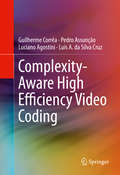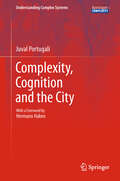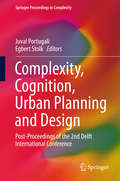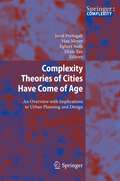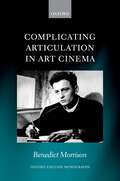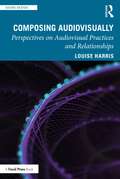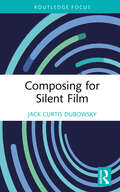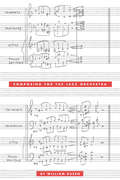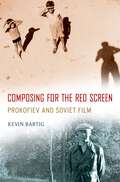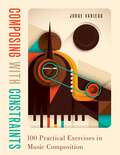- Table View
- List View
Complexity-Aware High Efficiency Video Coding
by Guilherme Corrêa Pedro Assunção Luciano Agostini Luis A. CruzThis book discusses computational complexity of High Efficiency Video Coding (HEVC) encoders with coverage extending from the analysis of HEVC compression efficiency and computational complexity to the reduction and scaling of its encoding complexity. After an introduction to the topic and a review of the state-of-the-art research in the field, the authors provide a detailed analysis of the HEVC encoding tools compression efficiency and computational complexity. Readers will benefit from a set of algorithms for scaling the computational complexity of HEVC encoders, all of which take advantage from the flexibility of the frame partitioning structures allowed by the standard. The authors also provide a set of early termination methods based on data mining and machine learning techniques, which are able to reduce the computational complexity required to find the best frame partitioning structures. The applicability of the proposed methods is finally exemplified with an encoding time control system that employs the best complexity reduction and scaling methods presented throughout the book. The methods presented in this book are especially useful in power-constrained, portable multimedia devices to reduce energy consumption and to extend battery life. They can also be applied to portable and non-portable multimedia devices operating in real time with limited computational resources.
Complexity, Cognition and the City (Understanding Complex Systems)
by Juval PortugaliComplexity, Cognition and the City aims at a deeper understanding of urbanism, while invoking, on an equal footing, the contributions both the hard and soft sciences have made, and are still making, when grappling with the many issues and facets of regional planning and dynamics. In this work, the author goes beyond merely seeing the city as a self-organized, emerging pattern of some collective interaction between many stylized urban "agents" – he makes the crucial step of attributing cognition to his agents and thus raises, for the first time, the question on how to deal with a complex system composed of many interacting complex agents in clearly defined settings. Accordingly, the author eventually addresses issues of practical relevance for urban planners and decision makers.The book unfolds its message in a largely nontechnical manner, so as to provide a broad interdisciplinary readership with insights, ideas, and other stimuli to encourage further research – with the twofold aim of further pushing back the boundaries of complexity science and emphasizing the all-important interrelation of hard and soft sciences in recognizing the cognitive sciences as another necessary ingredient for meaningful urban studies.
Complexity, Cognition, Urban Planning and Design: Post-Proceedings of the 2nd Delft International Conference (Springer Proceedings in Complexity)
by Juval Portugali Egbert StolkThis book, which resulted from an intensive discourse between experts from several disciplines – complexity theorists, cognitive scientists, philosophers, urban planners and urban designers, as well as a zoologist and a physiologist – addresses various issues regarding cities. It is a first step in responding to the challenge of generating just such a discourse, based on a dilemma identified in the CTC (Complexity Theories of Cities) domain. The latter has demonstrated that cities exhibit the properties of natural, organic complex systems: they are open, complex and bottom-up, have fractal structures and are often chaotic. CTC have further shown that many of the mathematical formalisms and models developed to study material and organic complex systems also apply to cities. The dilemma in the current state of CTC is that cities differ from natural complex systems in that they are hybrid complex systems composed, on the one hand, of artifacts such as buildings, roads and bridges, and of natural human agents on the other. This raises a plethora of new questions on the difference between the natural and the artificial, the cognitive origin of human action and behavior, and the role of planning and designing cities. The answers to these questions cannot come from a single discipline; they must instead emerge from a discourse between experts from several disciplines engaged in CTC.
Complexity of Constraints: An Overview of Current Research Themes (Lecture Notes in Computer Science #5250)
by Nadia Creignou Phokion G. Kolaitis Heribert VollmerNowadays constraint satisfaction problems (CSPs) are ubiquitous in many different areas of computer science, from artificial intelligence and database systems to circuit design, network optimization, and theory of programming languages. Consequently, it is important to analyze and pinpoint the computational complexity of certain algorithmic tasks related to constraint satisfaction. The complexity-theoretic results of these tasks may have a direct impact on, for instance, the design and processing of database query languages, or strategies in data-mining, or the design and implementation of planners. This state-of-the-art survey contains the papers that were invited by the organizers after conclusion of an International Dagstuhl-Seminar on Complexity of Constraints, held in Dagstuhl Castle, Germany, in October 2006. A number of speakers were solicited to write surveys presenting the state of the art in their area of expertise. These contributions were peer-reviewed by experts in the field and revised before they were collated to the 9 papers of this volume. In addition, the volume contains a reprint of a survey by Kolaitis and Vardi on the logical approach to constraint satisfaction that first appeared in 'Finite Model Theory and its Applications', published by Springer in 2007.
Complexity / simplicity: Moments in television (The Television Series)
by Jonathan Bignell Lucy Fife Donaldson Sarah CardwellAn exciting new strand in The Television Series, the ‘Moments in Television’ collections celebrate the power and artistry of television, whilst interrogating key critical concepts in television scholarship.Each ‘Moments’ book is organised around a provocative binary theme. Complexity / simplicity addresses the idea of complex TV, examining its potential, limitations and impact upon creative and interpretative practices. It also reassesses simplicity as an alternative criterion for evaluation. Complexity and simplicity persuasively illuminate the book’s chosen programmes in new ways.The book explores an eclectic range of TV fictions, dramatic and comedic. Contributors from diverse perspectives come together to expand and enrich the kind of close analysis most commonly found in television aesthetics. Sustained, detailed programme analyses are sensitively framed within historical, technological, institutional, cultural, creative and art-historical contexts.
Complexity / simplicity: Moments in television (The Television Series)
by Jonathan Bignell Lucy Fife Donaldson Sarah CardwellAn exciting new strand in The Television Series, the ‘Moments in Television’ collections celebrate the power and artistry of television, whilst interrogating key critical concepts in television scholarship.Each ‘Moments’ book is organised around a provocative binary theme. Complexity / simplicity addresses the idea of complex TV, examining its potential, limitations and impact upon creative and interpretative practices. It also reassesses simplicity as an alternative criterion for evaluation. Complexity and simplicity persuasively illuminate the book’s chosen programmes in new ways.The book explores an eclectic range of TV fictions, dramatic and comedic. Contributors from diverse perspectives come together to expand and enrich the kind of close analysis most commonly found in television aesthetics. Sustained, detailed programme analyses are sensitively framed within historical, technological, institutional, cultural, creative and art-historical contexts.
Complexity Theories of Cities Have Come of Age: An Overview with Implications to Urban Planning and Design
by Juval Portugali, Han Meyer, Egbert Stolk and Ekim TanToday, our cities are an embodiment of the complex, historical evolution of knowledge, desires and technology. Our planned and designed activities co-evolve with our aspirations, mediated by the existing technologies and social structures. The city represents the accretion and accumulation of successive layers of collective activity, structuring and being structured by other, increasingly distant cities, reaching now right around the globe.This historical and structural development cannot therefore be understood or captured by any set of fixed quantitative relations. Structural changes imply that the patterns of growth, and their underlying reasons change over time, and therefore that any attempt to control the morphology of cities and their patterns of flow by means of planning and design, must be dynamical, based on the mechanisms that drive the changes occurring at a given moment.This carefully edited post-proceedings volume gathers a snapshot view by leading researchers in field, of current complexity theories of cities. In it, the achievements, criticisms and potentials yet to be realized are reviewed and the implications to planning and urban design are assessed.
Complicating Articulation in Art Cinema (Oxford English Monographs)
by Benedict MorrisonComplicating Articulation in Art Cinema argues that art cinema draws attention to its disjointed, multi-parted form, but that criticism has too frequently sought to explain this complexity away by stitching the parts together in totalizing readings. This stitching together has often relied on the assumption that the solution to art cinema's puzzles lies in interpreting each film as the expression of a focalizing character's internal disturbance. This book challenges this assumption. It argues that the attempt to explain formal complexity through this character-centric approach reduces formal achievements and enigmatic characters to inadequate approximations of one another. Reference to character cannot fully tame unschematic and unpredictable combinations of - and collisions between - contradictory levels of narration, clashing styles, discontinuously edited shots, jarring allusions, dislocated genre signifiers, and intermedial elements. Through close analyses of films by Roberto Rossellini, Robert Bresson, Luis Buñuel, Terence Davies, Peter Greenaway, and Kelly Reichardt, Complicating Articulation in Art Cinema offers an ethics of criticism that suggests that the politics of art cinema's eccentric form are limited by character-centred readings. Each of the featured films presents inarticulate characters, whose emotional and intellectual lives are unknowable, further complicating the relationship between character and form. This book argues that, by acknowledging this resistance to interpretation, critics can think in new ways about art cinema's interrogation of the possibilities of knowledge.
Complicating Articulation in Art Cinema (Oxford English Monographs)
by Benedict MorrisonComplicating Articulation in Art Cinema argues that art cinema draws attention to its disjointed, multi-parted form, but that criticism has too frequently sought to explain this complexity away by stitching the parts together in totalizing readings. This stitching together has often relied on the assumption that the solution to art cinema's puzzles lies in interpreting each film as the expression of a focalizing character's internal disturbance. This book challenges this assumption. It argues that the attempt to explain formal complexity through this character-centric approach reduces formal achievements and enigmatic characters to inadequate approximations of one another. Reference to character cannot fully tame unschematic and unpredictable combinations of - and collisions between - contradictory levels of narration, clashing styles, discontinuously edited shots, jarring allusions, dislocated genre signifiers, and intermedial elements. Through close analyses of films by Roberto Rossellini, Robert Bresson, Luis Buñuel, Terence Davies, Peter Greenaway, and Kelly Reichardt, Complicating Articulation in Art Cinema offers an ethics of criticism that suggests that the politics of art cinema's eccentric form are limited by character-centred readings. Each of the featured films presents inarticulate characters, whose emotional and intellectual lives are unknowable, further complicating the relationship between character and form. This book argues that, by acknowledging this resistance to interpretation, critics can think in new ways about art cinema's interrogation of the possibilities of knowledge.
Complicit (Oberon Modern Plays)
by Joe SuttonSutton’s Complicit is a powerful play that explores the world’s current political climate and the consequences that arise when civil liberties become a privilege rather than a universal right.There's a hard road; there's an easy road - which one would you take? Pulitzer Prize winning journalist Ben Kritzer finds himself faced with this very dilemma, as he is stands in front of a Supreme Court Grand Jury. Will Kritzer defend his belief in the freedom of the press, or will he protect his family from the threats facing them?Refusing to hold any punches, Complicit is a political thriller bound to have you questioning your belief in the state and personal security. Gritty, provocative and poignant, Complicit is a thought-provoking and timely play with deep rooted significance within our society. A production directed by Kevin Spacey opens at the Old Vic Theatre, London in February 2009.
Complicite, Theatre and Aesthetics: From Scraps of Leather
by Tomasz WiśniewskiThis book presents a pioneering critical study of Complicite’s work throughout the years. Drawing on an extensive overview of the available research material – including interviews, manuscripts and the company’s own archive – the book is framed within a clearly defined research perspective and explores the singularity of theatre communication. The book results from an encounter between the London-based – but cosmopolitan in scope – company, and a fresh application of the form-oriented scholarship of Eastern Europe, Yuri Lotman’s semiosphere in particular. Focused on the aesthetics of Complicite, this study achieves a critical distance and undertakes multidimensional scrutiny of the available research material. By identifying the principles of Complicite’s aesthetics, the book attempts to grasp the company’s artistic paradigm. It focuses on ways of creating, preserving, and decoding meanings, rather than on the nuances of performance or contextual issues.
Composing Audiovisually: Perspectives on audiovisual practices and relationships (Sound Design)
by Louise HarrisWhat does the Coen Brothers’ Barton Fink have in common with Norman McLaren’s Synchromy? Or with audiovisual sculpture? Or contemporary music video? Composing Audiovisually interrogates how the relationship between the audiovisual media in these works, and our interaction with them, might allow us to develop mechanisms for talking about and understanding our experience of audiovisual media across a broad range of modes. Presenting close readings of audiovisual artefacts, conversations with artists, consideration of contemporary pedagogy and a detailed conceptual and theoretical framework that considers the nature of contemporary audiovisual experience, this book attempts to address gaps in our discourse on audiovisual modes, and offer possible starting points for future, genuinely transdisciplinary thinking in the field.
Composing Audiovisually: Perspectives on audiovisual practices and relationships (Sound Design)
by Louise HarrisWhat does the Coen Brothers’ Barton Fink have in common with Norman McLaren’s Synchromy? Or with audiovisual sculpture? Or contemporary music video? Composing Audiovisually interrogates how the relationship between the audiovisual media in these works, and our interaction with them, might allow us to develop mechanisms for talking about and understanding our experience of audiovisual media across a broad range of modes. Presenting close readings of audiovisual artefacts, conversations with artists, consideration of contemporary pedagogy and a detailed conceptual and theoretical framework that considers the nature of contemporary audiovisual experience, this book attempts to address gaps in our discourse on audiovisual modes, and offer possible starting points for future, genuinely transdisciplinary thinking in the field.
Composing for Silent Film
by Jack Curtis DubowskyComposing for Silent Film offers insight, information, and techniques for contemporary composition, arrangement, and live score performance for period silent film. A specialized music composition guide, this book complements existing film scoring and contemporary music composition texts. This book helps today’s composers better understand and correctly interpret period silent film, and to create and perform live scores that align with films’ original intentions, so that audiences notice and grasp fine points of the original film. Composing for Silent Film analyzes period silent film and its conventions – from Delsarte acting gestures to period fascinations and subtexts. As a practical composition text, it weighs varying approaches, including improvisation, through-scoring, "mickey-mousing," handling dialogue, and dividing roles amongst players. It steers composers towards informed understanding of silent film, and encourages them to deploy contemporary styles and techniques in exciting ways.For clarity and concision, examples are limited to nine canonical silents: Metropolis, Dr. Jekyll and Mr. Hyde, The Mark of Zorro, Sunrise: A Song of Two Humans, The Black Pirate, Nosferatu, The Phantom Carriage, Daisy Doodad’s Dial, and The Golem.
Composing for Silent Film
by Jack Curtis DubowskyComposing for Silent Film offers insight, information, and techniques for contemporary composition, arrangement, and live score performance for period silent film. A specialized music composition guide, this book complements existing film scoring and contemporary music composition texts. This book helps today’s composers better understand and correctly interpret period silent film, and to create and perform live scores that align with films’ original intentions, so that audiences notice and grasp fine points of the original film. Composing for Silent Film analyzes period silent film and its conventions – from Delsarte acting gestures to period fascinations and subtexts. As a practical composition text, it weighs varying approaches, including improvisation, through-scoring, "mickey-mousing," handling dialogue, and dividing roles amongst players. It steers composers towards informed understanding of silent film, and encourages them to deploy contemporary styles and techniques in exciting ways.For clarity and concision, examples are limited to nine canonical silents: Metropolis, Dr. Jekyll and Mr. Hyde, The Mark of Zorro, Sunrise: A Song of Two Humans, The Black Pirate, Nosferatu, The Phantom Carriage, Daisy Doodad’s Dial, and The Golem.
Composing for the Jazz Orchestra
by William Russo"Although it will be of primary interest to those who are engaged in composition themselves, [this] book is also recommended for readers who may wish to gain further insight into just what makes jazz composition so different from traditional approaches."—Malcolm Bessom, The Music Magazine
Composing for the Jazz Orchestra
by William Russo"Although it will be of primary interest to those who are engaged in composition themselves, [this] book is also recommended for readers who may wish to gain further insight into just what makes jazz composition so different from traditional approaches."—Malcolm Bessom, The Music Magazine
Composing for the Jazz Orchestra
by William Russo"Although it will be of primary interest to those who are engaged in composition themselves, [this] book is also recommended for readers who may wish to gain further insight into just what makes jazz composition so different from traditional approaches."—Malcolm Bessom, The Music Magazine
Composing for the Jazz Orchestra
by William Russo"Although it will be of primary interest to those who are engaged in composition themselves, [this] book is also recommended for readers who may wish to gain further insight into just what makes jazz composition so different from traditional approaches."—Malcolm Bessom, The Music Magazine
Composing for the Red Screen: Prokofiev and Soviet Film (Oxford Music / Media)
by Kevin BartigSound film captivated Sergey Prokofiev during the final two decades of his life: he considered composing for nearly two dozen pictures, eventually undertaking eight of them, all Soviet productions. Hollywood luminaries such as Gloria Swanson tempted him with commissions, and arguably more people heard his film music than his efforts in all other genres combined. Films for which Prokofiev composed, in particular those of Sergey Eisenstein, are now classics of world cinema. Drawing on newly available sources, Composing for the Red Screen examines - for the first time - the full extent of this prodigious cinematic career. Author Kevin Bartig examines how Prokofiev's film music derived from a self-imposed challenge: to compose "serious" music for a broad audience. The picture that emerges is of a composer seeking an individual film-music voice, shunning Hollywood models and objecting to his Soviet colleagues' ideologically expedient film songs. Looking at Prokofiev's film music as a whole - with well-known blockbusters like Alexander Nevsky considered alongside more obscure or aborted projects - reveals that there were multiple solutions to the challenge, each with varying degrees of success. Prokofiev carefully balanced his own populist agenda, the perceived aesthetic demands of the films themselves, and, later on, Soviet bureaucratic demands for accessibility.
Composing for the Screen (PERFORM)
by Scott W. HallgrenThis book is a collection of essays written by and interviews with working composers for film and television, and video games, exploring the business side of composing, addressing the lack of understanding about career development and business responsibilities as they relate to composers. Over 30 industry professionals, composers, directors, educators and business agents at all levels dispel myths about the industry and provide practical advice on topics such as how to break into the field; how to develop, nurture, and navigate business relationships; and how to do creative work under pressure. Readers will also learn about the entrepreneurial expectations in relation to marketing, strategies for contending with the emotional highs and lows of composing, and money management whilst pursuing a career in composing. Written for undergraduates and graduates studying composing, sound production, and filmmaking, as well as aspiring composers for film, TV, and games, this book provides readers with a wealth of first-hand information that will help them create their own opportunities and pursue a career in film and television.
Composing for the Screen (PERFORM)
by Scott W. HallgrenThis book is a collection of essays written by and interviews with working composers for film and television, and video games, exploring the business side of composing, addressing the lack of understanding about career development and business responsibilities as they relate to composers. Over 30 industry professionals, composers, directors, educators and business agents at all levels dispel myths about the industry and provide practical advice on topics such as how to break into the field; how to develop, nurture, and navigate business relationships; and how to do creative work under pressure. Readers will also learn about the entrepreneurial expectations in relation to marketing, strategies for contending with the emotional highs and lows of composing, and money management whilst pursuing a career in composing. Written for undergraduates and graduates studying composing, sound production, and filmmaking, as well as aspiring composers for film, TV, and games, this book provides readers with a wealth of first-hand information that will help them create their own opportunities and pursue a career in film and television.
Composing with Constraints: 100 Practical Exercises in Music Composition
by Jorge VariegoComposing with Constraints: 100 Practical Exercises in Music Composition provides an innovative approach to the instruction of the craft of music composition based on tailored exercises to help students develop their creativity. When composition is condensed to a series of logical steps, it can then be taught and learned more efficiently. With this approach in mind, Jorge Variego offers a variety of practical exercises to help student composers and instructors to create tangible work plans with high expectations and successful outcomes. Each chapter starts with a brief note on terminology and general recommendations for the instructor. The first five chapters offer a variety of exercises that range from analysis and style imitation to the use of probabilities. The chapter about pre-compositional approaches offers original techniques that a student composer can implement in order to start a new work. Based on lateral thinking, the last section of the book fosters creative connections with other disciplines such as math, visual arts, and architectural acoustics. The one hundred exercises contain a unique set of guidelines and constraints that place students in a specific compositional framework. These compositional boundaries encourage students to produce creative work within a given structure. Using the methodologies in this book, students will be able to create their own outlines for their compositions, making intelligent and educated compositional choices that balance reasoning with intuition.
Composing with Constraints: 100 Practical Exercises in Music Composition
by Jorge VariegoComposing with Constraints: 100 Practical Exercises in Music Composition provides an innovative approach to the instruction of the craft of music composition based on tailored exercises to help students develop their creativity. When composition is condensed to a series of logical steps, it can then be taught and learned more efficiently. With this approach in mind, Jorge Variego offers a variety of practical exercises to help student composers and instructors to create tangible work plans with high expectations and successful outcomes. Each chapter starts with a brief note on terminology and general recommendations for the instructor. The first five chapters offer a variety of exercises that range from analysis and style imitation to the use of probabilities. The chapter about pre-compositional approaches offers original techniques that a student composer can implement in order to start a new work. Based on lateral thinking, the last section of the book fosters creative connections with other disciplines such as math, visual arts, and architectural acoustics. The one hundred exercises contain a unique set of guidelines and constraints that place students in a specific compositional framework. These compositional boundaries encourage students to produce creative work within a given structure. Using the methodologies in this book, students will be able to create their own outlines for their compositions, making intelligent and educated compositional choices that balance reasoning with intuition.
Composite Materials: Sustainable and Eco-Friendly Materials and Application (The Minerals, Metals & Materials Series)
by Brian Wisner Simona E. Hunyadi Murph Ioannis N. Mastorakos Muralidharan ParamsothyThis collection covers innovations in the field of composite materials with a specific focus on eco-friendly and environmentally sustainable systems. All composite fields are explored, including polymer, metal, and ceramic matrix composites with an emphasis on sourcing raw materials in a sustainable way as well as the development of composite materials for environmental sustainability. Topics will include the development of new materials for structural applications, reduction in energy consumption, and increased component life along with discussions of novel methods to reuse existing materials. Additional topics include, but are not limited to:· Naturally Sourced Materials feedstock · Recycled Material feedstock, · Application of composite for reduced carbon footprint · Development of novel materials to repurpose waste from other areas
